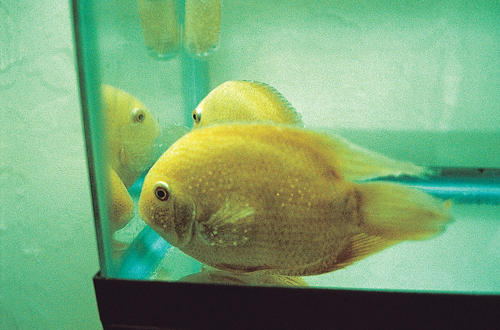Difference between revisions of "Ornamental Fish Q&A 11"
| (3 intermediate revisions by 2 users not shown) | |||
| Line 1: | Line 1: | ||
| − | [[|centre|500px]] | + | {{Manson |
| + | |book = Ornamental Fish Q&A}} | ||
| + | |||
| + | [[File:Ornamental Fish 11.jpg|centre|500px]] | ||
<br /> | <br /> | ||
| Line 14: | Line 17: | ||
Identification of ''I. multifiliis'' should be confirmed by taking a sample of skin mucus from an area exhibiting white spots, preparing a wet mount, and examining it with a light microscope. | Identification of ''I. multifiliis'' should be confirmed by taking a sample of skin mucus from an area exhibiting white spots, preparing a wet mount, and examining it with a light microscope. | ||
| − | |l1= | + | |l1=Ichthyophthirius multifiliis |
|q2=What is the most probable source of the infection? | |q2=What is the most probable source of the infection? | ||
|a2= | |a2= | ||
The affected fish were most probably carriers of the infection. Fish that survive infection by ''I. multifiliis'' retain some immunity to the organism, but may carry a small number of encysted parasites that emerge at a later time, frequently following a change (usually a decrease) in water temperature. | The affected fish were most probably carriers of the infection. Fish that survive infection by ''I. multifiliis'' retain some immunity to the organism, but may carry a small number of encysted parasites that emerge at a later time, frequently following a change (usually a decrease) in water temperature. | ||
| − | |l2= | + | |l2=Ichthyophthirius multifiliis |
|q3=How should the problem be managed? | |q3=How should the problem be managed? | ||
|a3= | |a3= | ||
| Line 28: | Line 31: | ||
of emerging tomites from the aquarium. | of emerging tomites from the aquarium. | ||
| − | A third strategy that can control I. multifiliis is careful cleaning of infested aquaria daily with particular attention paid to siphon particulate debris from the bottom and sides of the glass. | + | A third strategy that can control ''I. multifiliis'' is careful cleaning of infested aquaria daily with particular attention paid to siphon particulate debris from the bottom and sides of the glass. |
| − | |l3= | + | |l3=Ichthyophthirius multifiliis |
</FlashCard> | </FlashCard> | ||
Latest revision as of 22:29, 30 October 2011
| This question was provided by Manson Publishing as part of the OVAL Project. See more Ornamental Fish Q&A. |
A pair of adult gold severums were purchased by a hobbyist for use as broodstock. They were placed in a 38-L aquarium equipped with a sponge filter and air stone. Water temperature was adjusted to 26°C (78.8°F). Seven days after arrival, the fish were lethargic and the owner noticed they were completely covered with white dots. He phoned the individual who had sold him the fish, a trusted friend, and was assured that the fish had never been sick during the 18 months they had been in his care. He had purchased them as juveniles from a reputable pet store and never had to question their health.
| Question | Answer | Article | |
| What is the most likely problem, and how would you confirm your diagnosis? | White spots on fish can have several causes. However, the most common cause of white spots on freshwater ornamental fish is the ciliated protozoan parasite Ichthyophthirius multifiliis. Identification of I. multifiliis should be confirmed by taking a sample of skin mucus from an area exhibiting white spots, preparing a wet mount, and examining it with a light microscope. |
Link to Article | |
| What is the most probable source of the infection? | The affected fish were most probably carriers of the infection. Fish that survive infection by I. multifiliis retain some immunity to the organism, but may carry a small number of encysted parasites that emerge at a later time, frequently following a change (usually a decrease) in water temperature. |
Link to Article | |
| How should the problem be managed? | Controlling I. multifiliis in a freshwater aquarium is relatively straightforward, and several approaches are possible. The first is simple chemical control, which implies application of an appropriate compound to the water, at a designated concentration for an appropriate period of time. Effective compounds include formalin (25 p.p.m. as an indefinite bath or 170–250 p.p.m. for 30–60 minutes), potassium permanganate (2 p.p.m. as an indefinite bath, or up to 10 p.p.m. for 30 minutes), copper sulfate (safe use is based on total alkalinity of the water), and salt (0.03% as an indefinite bath or 3% for up to 10 minutes – when the fish rolls over and appears stressed, move it to fresh water). A second strategy used to control I. multifiliis is temperature control. Tomites (juveniles) are not tolerant of water temperatures above 32°C (89.6°F). Raising water temperature to this level for five consecutive days is effective in elimination of emerging tomites from the aquarium. A third strategy that can control I. multifiliis is careful cleaning of infested aquaria daily with particular attention paid to siphon particulate debris from the bottom and sides of the glass. |
Link to Article | |
